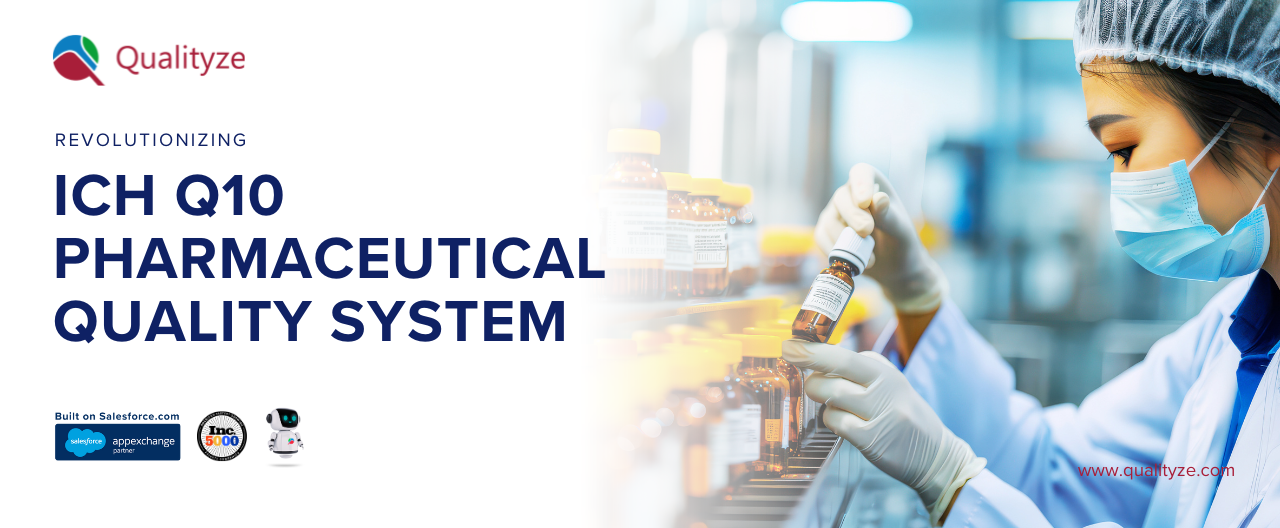Calculate your potential savings with our ROI Calculator
ROI CalculatorCalculate your potential savings with our ROI Calculator
ROI Calculator1 What is the ICH Q10 Pharmaceutical Quality System?
2 What is the Objective of ICH Q10?
3 ICH Q10 Guidelines
4 Elements of Pharmaceutical Quality Systems in ICH Q10
5 ICH Q10 Pharmaceutical Quality System Model
6 ICH Q10 Pharmaceutical Quality System Lifecycle
7 Stages of the ICH Q10 Pharmaceutical Lifecycle
8 Parting Shot

Maintaining stringent quality standards is a regulatory requirement and a fundamental necessity for ensuring medicinal products' safety, efficacy, and reliability in the pharmaceutical industry. The ICH Q10 guideline is one crucial framework that has transformed the approach to quality management in the pharmaceutical industry.
Imagine a world where every medication you take is safe, effective, and reliable. The vision behind ICH Q10 is to ensure that every medication we take is safe, effective, and reliable. It is a groundbreaking guideline that is transforming how pharmaceutical companies ensure the quality of their products.
This blog discusses ICH Q10, its objectives, guidelines, elements, and the lifecycle it encompasses.
ICH Q10, short for International Council for Harmonisation of Technical Requirements for Pharmaceuticals for Human Use - Quality Guideline Q10, is a globally recognized standard for pharmaceutical quality management systems. Established by the International Council for Harmonisation (ICH), which comprises regulatory authorities and pharmaceutical industry representatives from Europe, Japan, the United States, Canada, and Switzerland, ICH Q10 aims to ensure consistent product quality and continual improvement throughout the product lifecycle. It incorporates best practices from various sources, including:
The primary objective of ICH Q10 is to cultivate a robust pharmaceutical quality system that enhances patient safety by focusing on product quality, effectively managing risks, and facilitating continual improvement and innovation in manufacturing processes. It seeks to harmonize approaches across different regulatory jurisdictions, promoting efficiency and reducing the regulatory burden on pharmaceutical companies.
The primary objective of ICH Q10 is to establish a unified, high-quality standard for pharmaceutical quality systems across the globe. This harmonization aims to:
The ICH Q10 guideline outlines a comprehensive approach to pharmaceutical quality management, emphasizing the integration of quality risk management, lifecycle concepts, and process performance and product quality monitoring. It provides a framework that encourages proactive quality management practices rather than reactive approaches, ensuring quality is built into the product through all stages of its lifecycle.
The ICH Q10 guideline is not a set of rigid rules. It offers a flexible framework that pharmaceutical companies can adapt to their specific needs. The core message is clear: a strong quality system should be built on a foundation of:
ICH Q10 set out several key elements that constitute an effective pharmaceutical quality system:
The ICH Q10 pharmaceutical quality system model is structured around a core set of principles:
The ICH Q10 guideline emphasizes a lifecycle approach to pharmaceutical quality, acknowledging that quality must be built into each product lifecycle stage. The lifecycle includes the following stages:
Related Article : 7 Common Compliance Issues Faced By Pharmaceutical Industry
ICH Q10 emphasizes the importance of integrating quality considerations into each lifecycle stage. For example, risk management techniques are used to identify potential quality issues during development, and QbD principles ensure the manufacturing process is designed to produce high-quality products consistently. The lifecycle stages in ICH Q10 are interconnected and iterative, fostering continual improvement and adaptation to new information and changing circumstances. Each stage involves specific activities aimed at ensuring product quality and patient safety:
ICH Q10 represents a paradigm shift in pharmaceutical quality management, emphasizing proactive approaches, continual improvement, and quality integration throughout the product lifecycle. By adhering to its guidelines and principles, pharmaceutical companies can enhance product quality, ensure patient safety, and streamline regulatory compliance in a globally harmonized manner.